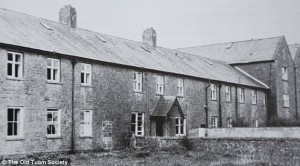
The Mother and Baby Home at Tuam
The Irish historian Catherine Corless talks about her work in uncovering the crimes committed against children out of wedlock in Ireland up until the 1960ties.
Catherine Corless remembers the children of the “St. Mary’s Mother and Baby Home” from her childhood. The home was run by nuns. What Corless did not know growing up was what crimes were committed there. She also could not imagine that she would be the one to uncover them.
In the middle of the 20th century unwed mothers were treated like criminals in Ireland. Pregnant girls where often sent by their families to these homes for mothers and children. They would give birth and live there for a year afterwards. The women would then return to their families while their children stayed with the nuns. Some were adopted. Many others died.
At the beginning of the Seventies two boys found an anonymous mass grave filled with children skeletons. Cathrine Corless, a historian from Tuam, started her own time intense and costly investigation a few years ago – she even bought copies of the death certificates of each child for 4 Euros each. She collected 796 death certificates of the children of St. Mary’s. They died there between 1925 and 1961. But they were not buried. They did not receive funerals.
Infant mortality was high in Ireland at the time. But not that high. According to the death certificates many died from diseases that could have been cured with medication. Did they not receive it? Did the nuns neglect the children?
Corless is not the only one starting to shed light onto the dark chapters of Ireland’s Catholic history. The movie “Philomena” with Judi Dench was an international success last year. It tells the story of a mother who goes to look for her son who had been given up for adoption by nuns against the mother’s will. The case was made public by the former BBC journalist Martin Sixsmith. Sixsmith came to visit Corless in Tuam last February.
Last week Corless’ research produced headlines world wide. The scandalous story of the dead baby corpses found in mass graves forced Prime Minister Enda Kenny to announce a national inquiry into all homes for unwed mothers and children in Ireland. For Catherine Corless this amounts to “a breakthrough”. She spoke to “profil” by phone in her house in Tuam.
Profil: Mrs. Corless, you discovered that 796 babies died in the St. Mary’s mother-and-baby Home in your town Tuam up until 1961. The general infant mortality in Ireland was always high – but not that high. There is an implicit accusation in your findings. Will there be criminal consequences?
Catherine Corless: There will be a public inquiry. The project was taken out of my hands, so I cannot comment now on the specifics as it is not up to me anymore.
Profil: But do you support the work of the committee and the inquiry?
Corless: Of course. My own work was always directed towards raising awareness for the fact that horrific things have happened. Now they will look at it on a national level. They will look into all cases of homes for unmarried women who gave birth to children out of wedlock. We will finally get to know the truth. This is all that counts. I always wanted to have a plaque installed for these babies who died here. They have to be properly remembered.
Profil: Do you think the mothers support this truth finding inquiry? They might be ashamed that their story is coming out and being inspected in every detail.
Corless: I have never met a mother who did not want to know what happened. I have also never heard of a mother who did not want everyone else to know how they were mistreated. You must understand that these women had no right to say what would happen to their children. I remember as a child we knew the home children. They would walk to school in a line, I remember the noise of their heavy clogs on the street. But they were not supposed to meet with us, they took them back to the home before school ended to avoid contact with us. When they were seven they were given up for adoption, or at least we did not see them anymore. And many, as I discovered, died in that home. Without a proper funeral.
Profil: Some reports said that the baby corpses were dumped in a septic tank, you have already denied this. What is the real story?
Corless: In the early Seventies two little boys played in the area and they noticed a slab. They broke off a bit and saw underneath a space filled with small skulls and bones. This was one part of the mass grave. A few people came and looked at it and they called a priest. He came and blessed the area. This was it. Does it matter if there were 500 or just 10 baby corpses in this particular place? Isn’t it horrific that something like this happened just next to us and nobody did anything about it?
Profil: Do you think everyone around you sees your role as a positive one? Is there hostility in the Catholic community against you?
Corless: To be honest, I have not left the house recently. I was too busy here. People are coming to me. But I can tell you this: Nobody rang me up and expressed negative feelings. When I did my research it was different. At that time I encountered a lot of animosity. But I think we are beyond this now. This is in any case not about me. We now work on the history of these homes on a national level. This is very important.
Profil: The turn of events is quite amazing for this conservative catholic environment, isn’t it? Your research has brought a real breakthrough.
Corless: Yes it has. It is really a very big breakthrough.
Interview: Tessa Szyszkowitz/London


